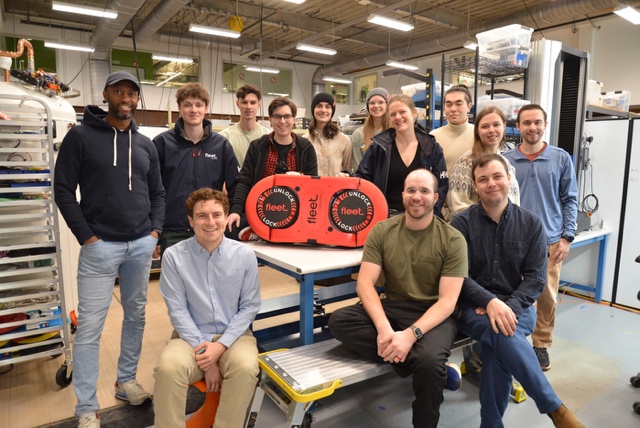Maritime shipping is responsible for about 3 percent of global greenhouse gas emissions—a tally so high that if the industry were a country, it’d be the sixth most polluting nation in the world.
One factor that drives up ships’ emissions is biofouling: the buildup of microorganisms, small animals, plants, and algae on the underside of ships. Biofouling causes drag, which can increase ships’ fuel consumption by 5 to 30 percent—a massive climate and financial impact, given that large vessels can burn up to 66 gallons per minute and use extraordinarily dirty fuel. This accumulation can also contribute to spreading invasive species throughout the world.
Fleet Robotics, a Greentown Labs member, is launching a new category of autonomous mobile robots (AMRs) that can easily scale vertical surfaces in the harshest of conditions—even under the sea. Its first use-case is tackling biofouling in the shipping industry with wireless, dextrous AMRs that reside on the vessel at all times and clean its exterior. The startup’s 50-pound robot can walk along the hull of a ship with unprecedented levels of adhesion.
Fleet Robotics’s solution improves on today’s approach to reducing biofouling, which involves coating hulls with toxic chemicals and periodic in-port cleanings. These coatings typically need to be redone every five years and become less effective with each year of use. In-port cleanings are expensive and are generally limited to only docked vessels.
“This is becoming a larger and larger problem, with an unsustainable end to it: the end looks like ‘let’s add more toxic chemicals to the coating so we can make the problem easier,’ but then the organisms get more used to those chemicals,” says Fleet Robotics’ CEO and co-founder Sidney McLaurin. “What we’re trying to do is give another tool to reset that path.”
The startup’s robots provide a simplified, reliable, economical, and climate-friendly alternative to reducing biofouling and drag—an offering not only valuable to its key customer groups of ship owners and operators, but also to insurance companies and port operators. Fleet Robotics’ system currently works on ferrous (iron) ship hulls, and the team plans to add capabilities for non-ferrous surfaces in the near future.
The TRL 5, eight-person company has identified its first customer and will pilot its technology in the first half of 2024. Fleet Robotics will also conduct extensive customer discovery in the coming year and encourages anyone interested in a partnership to get in touch. The startup may consider additional applications for its robotic technology in the future, according to McLaurin.
Prior to founding Fleet Robotics, McLaurin was a partner at Material Impact, where he worked extensively in ocean tech. He set out to launch a startup addressing one of the ocean’s key challenges, and identified biofouling with his co-founder Michael Bell—a robotics expert and the startup’s CTO—and Robert Wood, an esteemed Harvard roboticist.
Fleet Robotics joined Greentown in 2022, and McLaurin says the incubator’s team and community of entrepreneurs have created a place where his startup can flourish.
“Having the supportive team at Greentown has been the biggest collective resource—having people really care about the success of your company, with proactiveness and thoughtfulness,” McLaurin says. “Their willingness to figure out a solution is what you need as an early-stage startup. The Greentown space feels like home, and I could not have asked for a better place to start a company.”

